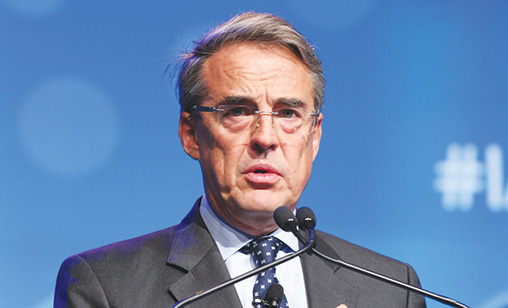News Backgrounder
Global air passenger growth moves east reports IATA
The global airline industry’s latest forecast underscored the fact that the powerhouse of aviation is moving east. It also highlighted the much repeated need for aviation infrastructure to keep pace with airline growth. Chief correspondent, Tom Ballantyne, reports.
November 1st 2018
It is what we all knew. Read More » Global air traffic will double to 8.2 billion annual travelers by 2037 and at least half of those additional 4.1 billion passengers will be flying in the Asia-Pacific, the International Air Transport Association (IATA) director general, Alexandre de Juniac, said in the association’s forecast last month.
Highlights of IATA’s latest 20-year air passenger forecast include the news that China will displace the United States as the world’s largest aviation market in the mid-2020s. India will take third place on the world table after the U.S. when it overtakes Britain in 2024.
 |
Indonesia will be a standout performer in the next decade, climbing from No. 10 on the industry table in 2017 to the fourth largest commercial airline market in the world by 2030. Thailand is expected to become one of the top 10 markets in 2030, replacing Italy which will drop out of the rankings.
Despite the big numbers, IATA’s de Juniac said while strong demand for air transport is good news, the connection between strong demand and profitability is not always assured. “Often, our ability to meet the needs of consumers and businesses is limited by the failure of governments to provide the infrastructure capacity required,” he said, and added the pressure on infrastructure to meet the demand is not likely to end soon.
The latest air traffic figures, for August, reveal that for the 31-day period airlines hit an all-time record load factor of 85.3%. Countering the high capacity record, de Juniac said the numbers in its new forecast were based on a constant policy scenario although there was much uncertainty about the direction of global politics and its impact on aviation.
“The forces of economic protectionism are casting a shadow over world trade and if the world proceeds towards this reverse globalization, passenger numbers will still grow but more slowly, initially by 2.4% annually instead of 3.5%,” he said.
“The future will be brighter if globalization wins and we see continuous liberalization and the opening of borders to people and trade. In that case, we see the potential for 5.5% average annual growth instead of the 3.5% in our reference scenario.”
IATA said a doubling of air passengers in the next 20 years could support 100 million jobs globally. No matter which growth scenario comes to pass, de Juniac said, aviation continues to face an infrastructure crisis.
“Governments must work closely with the industry, to be more ambitious in developing efficient infrastructure that is fit for purpose and offers value for money. The world stands to benefit greatly from better connectivity,” he said.
“However, at this rate, airports and air traffic control will not be able to handle demand. Governments and infrastructure operators must strategically plan for the future. Decisions made now will have an impact on the value created by aviation for their regions.
“Global prosperity depends on air connectivity. Aviation is sensitive to policies that either support or undermine growth. And these seem to be pointing in the wrong direction. Dampening demand for air connectivity risks high quality jobs and economic activity dependent on global mobility.
“This forecast is a cautionary warning to governments. First, the industry will grow but they must clear the infrastructure bottlenecks to bring that growth to their home markets. Secondly, governments must understand globalization has made our world more socially and economically prosperous. Inhibiting globalization with protectionism will see opportunities lost.”